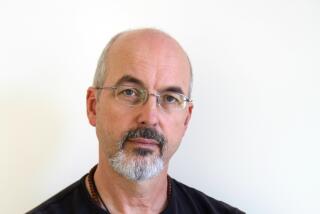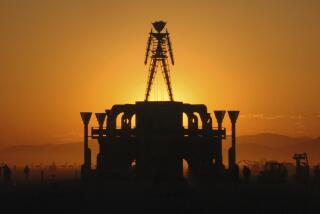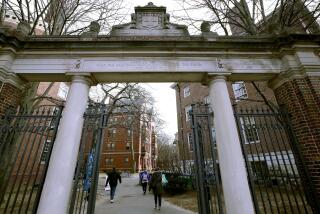Smithsonian’s chief says removal of video was hasty
- Share via
G. Wayne Clough, the Smithsonian Institution’s chief executive, said Thursday that Republican House leaders’ threats of budgetary consequences factored into his Nov. 30 decision to remove a video from a National Portrait Gallery exhibition of work done primarily by artists who are gay and lesbian.
In a brief interview after speaking at the Town Hall Los Angeles public issues forum at the Millennium Biltmore Hotel, Clough, who has been the secretary of the Smithsonian 2 1/2 years, said he wishes he had taken more time and spoken to more art experts before making the decision. “It’s the most painful thing I’ve ever done,” he said.
But he said he didn’t consider it an act of censorship because in making the decision, “I didn’t judge this work of art.”
Clough said he was stuck at the Atlanta airport on Nov. 30 when the news broke that Reps. John A. Boehner (R-Ohio) and Eric Cantor (R-Va.), now speaker of the House of Representatives and House majority leader, respectively, had said the Smithsonian’s budget could suffer if didn’t address concerns that “Hide/Seek: Difference and Desire in American Portraiture” displayed anti-Christian content. Taxpayer funding accounts for about three-quarters of the Smithsonian’s $1-billion budget.
The same day, William Donohue, president of the Catholic League, had branded the show’s four-minute excerpt of “A Fire in My Belly,” a 1987 video by David Wojnarowicz, as “hate speech” because it includes brief footage of ants crawling over a crucifix.
By day’s end, without trying to contact the congressional critics, Clough had ordered it removed. The National Portrait Gallery subsequently explained on its website that the removed piece is “a surrealistic video collage … expressing the suffering, marginalization and physical decay” of AIDS patients, rather than a condemnation of Christianity.”
“Sure, that was part of it,” Clough said when asked whether he was concerned the Smithsonian’s budget would be slashed in retaliation. “It was one of a number” of considerations, he said, prominent among them a determination to defuse the potential for a media hurricane in which the merits and meaning of the art in “Hide/Seek” would be ignored amid shouting about cultural values and government support for the arts.
“It would be a hullabaloo over it,” said Clough. “These things crescendo and when they take off you lose … control,” so that it becomes “not a debate about the quality of the exhibition, but issues somebody is trying to hijack.... There has been a history of similar episodes. They have led to difficult debates with devastating impact on institutions.”
Clough said fighting critics would have undermined the purpose of the exhibition, which he said the Smithsonian is especially proud of because it’s an unprecedented examination of gay artists’ sensibilities in a major museum.
Clough said he hadn’t seen Wojnarowicz’s video, one of 105 artworks in the show and “a late addition” that was accessible only via a touch-screen. He said he consulted with Martin Sullivan, director of the National Portrait Gallery, and curator David Ward. They both “felt it had its merits as a work of art, but didn’t add much” to the overall exhibition, Clough said. “Hardly anyone was looking at it. That was the ironic thing.”
But Clough said he wishes he had taken more time with his decision and consulted more people, including the directors of the other art museums under the Smithsonian’s umbrella.
The consequence has been outrage and protests in the art community, including a quiet procession Thursday outside the Millennium Biltmore before Clough’s arrival, led by a marcher bearing a white cross adorned with a cutout of Jesus from the expunged video. The Andy Warhol Foundation for the Visual Arts, which had helped fund “Hide/Seek,” has vowed to end support for the Smithsonian.
Clough acknowledged that “there is a concern, absolutely,” that the Smithsonian could lose donors, and cooperation from collectors and museums it counts on to loan it artworks and artifacts to flesh out an average of nearly 100 exhibitions a year. “There is damage in the arts community, and it’s part of my job to reach out and say, ‘What can we do to restore your faith?’ ” Clough said.
Robert Lynch, president of Americans for the Arts, a Washington-based advocacy group , said Wednesday that he hopes the episode will illustrate the need for careful deliberation over arts policy, rather than what he sees as rash, under-informed attacks on “Hide/Seek” and a too-hasty reaction by the Smithsonian.
If this sets a norm, Lynch said, “nothing would prevent elected leaders who have power of the purse from looking at anything and saying, ‘I don’t like that,’ and, boom — it’s gone. That’s not our system.”
More to Read
The biggest entertainment stories
Get our big stories about Hollywood, film, television, music, arts, culture and more right in your inbox as soon as they publish.
You may occasionally receive promotional content from the Los Angeles Times.











